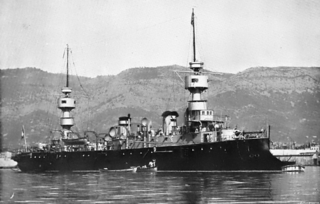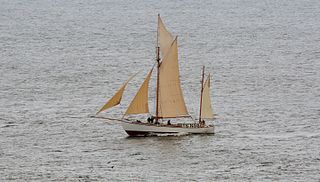
USS Des Moines (C-15/PG-29/CL-17) was a protected cruiser of the Denver class in the United States Navy during World War I. She was the first Navy ship named for the city of Des Moines, Iowa.

German submarine U-49 was a Type VIIB U-boat of Nazi Germany's Kriegsmarine during World War II. She was ordered on 21 November 1936 and laid down on 15 September 1938 at the yards of Friedrich Krupp Germaniawerft AG in Kiel as yard number 584. Launched on 24 June 1939, she was commissioned on 12 August and assigned to the 7th U-Boat Flotilla under the command of Kurt von Goßler.

SM UB-5 was a German Type UB I submarine or U-boat in the Imperial German Navy during World War I. She sank five ships during her career and was broken up in Germany in 1919.
SM UB-17 was a German Type UB I submarine or U-boat in the German Imperial Navy during World War I. The submarine disappeared during a patrol in March 1918.

The Amiral Charner class was a group of four armoured cruisers built for the French Navy during the 1890s. They were designed to be smaller and cheaper than the preceding design while also serving as commerce raiders in times of war. Three of the ships were assigned to the International Squadron off the island of Crete during the 1897–1898 uprising there and the Greco-Turkish War of 1897 to protect French interests and citizens. With several exceptions the sister ships spent most of the first decade of the 20th century serving as training ships or in reserve. Bruix aided survivors of the devastating eruption of Mount Pelée on the island of Martinique in 1902. Chanzy was transferred to French Indochina in 1906 and ran aground off the Chinese coast in mid-1907. She proved impossible to refloat and was destroyed in place.
Sibylle (Q175) was a Diane-class submarine of the French Navy commissioned in 1934. During World War II, she operated on the Allied side until 1940, when she became part of the naval forces of Vichy France. She disappeared during Operation Torch, the Allied invasion of French North Africa, in November 1942.

Kommuna is a submarine salvage ship in service with the Russian Navy's Black Sea Fleet and the world's oldest active duty naval vessel. A double-hulled catamaran, she was laid down at the Putilov Factory in St. Petersburg in November 1912 as Volkhov. The ship was launched the following year, and commissioned on 14 July 1915. She was renamed Kommuna on 31 December 1922. Kommuna has served in the Russian Imperial, Soviet, and Russian Federation navies through the Russian Revolution and two World Wars.

Wyvern is a 60-foot (18 m) open sea sailing ship operated by Stavanger Maritime Museum. The ship was designed by Colin Archer on a commission from British-born Frederick Croft and was launched on 10 August 1897. She sailed under the German flag from 1909. The Norwegian newspaper editor Rolf Thommessen bought her in 1924 and renamed her Havfruen III. This name was kept by the English owners, Anne and Terrence Carr, who acquired her in 1947 and sold her to Christian-Frederick Mattner in 1970--who renamed her to the original 'Wyvern'.She was contracted for sale to a Norwegian consortium for £ 50 000 //of which £30 000 is still owed// after having been hijacked from San Antonio Ibiza.
The Cemfjord was a Cyprus-registered cargo ship which foundered in the Pentland Firth off the north-east coast of Scotland on 2 January 2015. Built as the general cargo ship Margareta in 1984, she was converted to carry cement in 1998 and was en route from Aalborg, Denmark to Runcorn, Cheshire, United Kingdom when she capsized in bad weather and sank in 82 metres (270 ft) of water. All eight crew were presumed lost. No bodies were recovered, and the ship has been left as a sea grave.
Adolf Vinnen was a weather ship that was built in 1929 as the fishing vessel Gustav Adolf Kühling. She was renamed in 1930. The ship was requisitioned by the Kriegsmarine in March 1940, serving until 23 October 1940 when she was sunk by HMS Matabele, HMS Punjabi and HMS Somali.
SS Oslo was a British passenger ship that was torpedoed by the German submarine SM U-87 in the North Sea 15 nautical miles (28 km) east by north of the Out Skerries, Shetland Islands. She was travelling from Trondheim, Norway to Liverpool, United Kingdom while carrying passengers and a cargo of copper ore.

The B 97 class was a class of eight destroyers built for and operated by the Imperial German Navy during the First World War. They served throughout the war, with one being lost in 1915, five being scuttled at Scapa Flow in 1919 and one being transferred to Italy, where it remained in use until 1939.
SS Rotterdam was a Dutch Passenger ship that ran aground and sunk on the Zeehondenbank near the Dutch island of Schouwen, while she was travelling from New York, United States to Rotterdam, The Netherlands.
ML-18 was a British motor launch boat that disappeared in the North Sea while on passage from Norway.
ML-62 was a British motor launch boat that disappeared in the North Sea while on passage from Norway.

Z31 was a German Type 1936A (Mob) destroyer, which was completed in 1942 and served with the Kriegsmarine during the Second World War. She was constructed in Germany as part of Plan Z, and commissioned 11 April 1942. She spent much of the war in Arctic and Norwegian waters, taking part in the Battle of the Barents Sea on 31 December 1942. She survived the war, and was passed on to the French Navy as a war prize, serving under the name Marceau until 1958.

SMS V191 was a S-138-class large torpedo boat of the Imperial German Navy. She was built by the AG Vulcan shipyard at Stettin between 1910 and 1911 and launched on 2 June 1911.
SMS S32 was a V25-class large torpedo boat of the Imperial German Navy that served during the First World War. She was built by the Schichau-Werke shipyard in Elbing, East Prussia, being launched on 28 February 1914 and was completed in September that year.
SS Rastrello was an Italian cargo ship that was sunk in a British air raid on 16 June 1940 in Naples, Italy.

Bezboyaznenny was a Sovremenny-class destroyer of the Soviet and later Russian navy.









